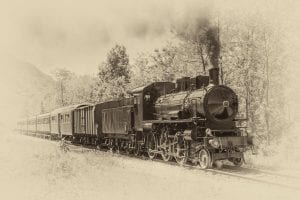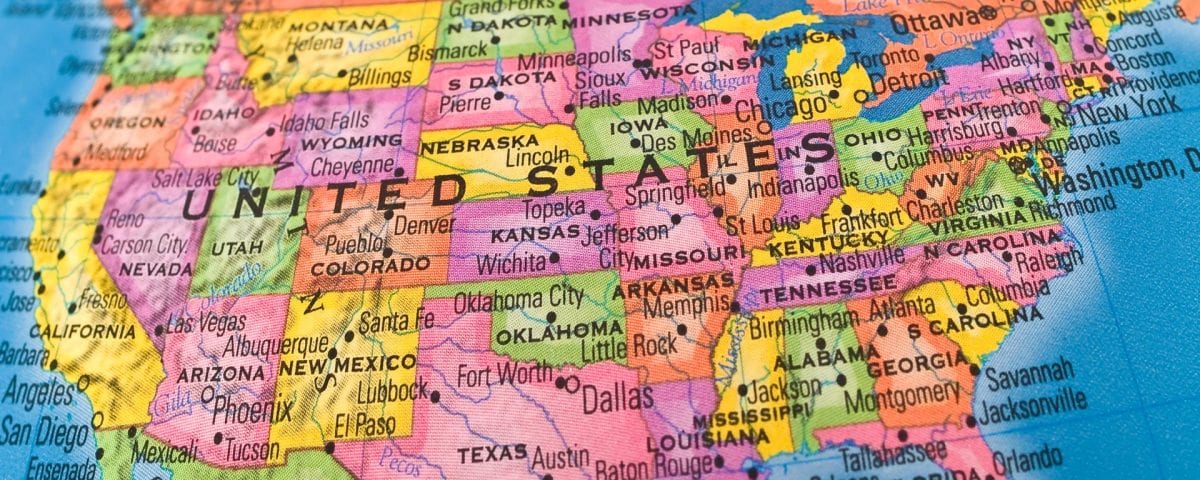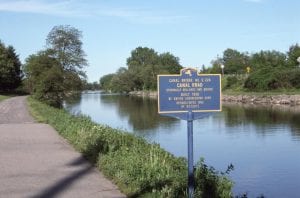
A River Runs Through Us
July 16, 2020
How Our Population Has Changed
December 9, 2020There were five developments that spurred the expansion of the United States in the 1800s.
They ranged from land acquisitions to transportation breakthroughs to pioneering acts.
All reshaped the country as it grew and industrialized.
Here’s a look at those five monumental events.
The Louisiana Purchase
The importance of the Louisiana Purchase should not be underestimated.
It had only been 20 years since the United States won its freedom from England when President Thomas Jefferson signed the agreement with French leader Napoleon Bonaparte in 1803.
The pact gave the United States another 828,000 square miles of land for $15 million, about 4 cents an acre. The acquisition doubled the size of the young nation. America morphed from a narrow section of land between the Mississippi River and the Atlantic Ocean into a country that owned almost all the territory from the Rocky Mountains to the Eastern seaboard.
The new section of the country would eventually be parceled into all or part of 15 new states.
More immediately, the Louisiana Territory connected smoothly with the Northwest Territory, which eventually would give birth to the states of Ohio, Michigan, Indiana, Illinois and Wisconsin.
More importantly, the Louisiana Territory provided the United States with control of the Mississippi River and the important port of New Orleans.
That opened up settlement of the Ohio Valley and Tennessee Valley. Residents there could now easily ship goods downriver.
It didn’t take long for pioneers to head to the new territory. In 1804, Jefferson sent Meriwether Lewis and William Clark to explore the new lands.
People who did venture into the new territory found it rich in gold, silver and other minerals. It also contained thick forests as well as fertile farmland. A 2003 article in the Smithsonian Magazine concluded that the Louisiana Purchase made the United States “immensely wealthy.”
The article quotes scholar and author Douglas Brinkley as saying the Declaration of Independence, the Constitution and the Louisiana Purchase are “the three things that created the modern United States.” He adds that the acquisition allowed the United States to become a “continental power.”
The Erie Canal
While traffic was starting to flow down the Mississippi and Ohio rivers, merchants in the Ohio Valley still needed a way to get their products to the Atlantic seaboard.
Enter the Erie Canal.
The waterway was built between 1817 and 1825. Originally, it traveled 363 miles from Buffalo to Albany in upstate New York. At first, it was only 4 feet deep and 40 feet wide.
Workers had to cut through fields, forests, swamps and rocky cliffs to complete it.
In the end, it was worth it. The canal in essence connected the Great Lakes via the Hudson River to the Atlantic Ocean.
The waterway was an immediate success. Traffic jams emerged on the popular channel and toll charges paid off the canal debt in 10 years. Towns such as Rochester, New York, sprung up along the canal corridor.
For passengers, the canal reduced the travel time from Albany to Buffalo from 12 rugged days by stagecoach to 5 leisurely days by boat.
For merchants, it sliced freight rates by 90 percent as shipping goods via water was a lot less expensive than by ox-driven carts. The cargo included produce from the Midwest as well as timber and manufactured goods from surrounding regions.
The canal fed right into the Hudson River at Albany, allowing products to be shipped all the way to the Eastern shore. The development transformed New York City into the country’s principal seaport, vaulting it over the previously larger ports of Boston, Philadelphia and New Orleans.
The economic benefits are credited with starting the consumer economy in the United States. Farmers who used to grow their own food and make their own household items could now sell their crops and have money to buy furniture and other necessities.
The canal opened the Ohio Valley and the territory farther west to further settlement. The cities of Cleveland and Toledo expanded rapidly after the canal was opened. The expansion did lead to encroachment on Native American land and the eventual removal of those tribes from the region.
The canal also helped bring a new breed of settler to the region. Most New Englanders were opposed to slavery, a diametric view to the Southerners who had been journeying up the Mississippi River to stake claims in this new land.
The canal was also good for the American psyche. At the time, it was considered a marvel of modern engineering and the greatest public works project in North America. It was also finished early and under budget. The canal is credited with provided a real-life educational opportunity for a generation of American engineers.
Historian Brad Utter told CBS News in 2017 that the impact Erie Canal on American society at the time was similar to the impact the Internet has had on today’s society.
The canal was eventually widened to 120 feet and dredged to 12 feet deep. It was also lengthened to 338 miles so that it connected the town of Waterford on the Hudson River to Lake Erie.
Railroads dealt the first blow to the Erie Canal in the late 1800s, first taking passengers and then eventually freight traffic.
The next blow was the completion of the St. Lawrence Seaway in 1959. That waterway allowed larger ships to cruise from the Atlantic Ocean directly to the Great Lakes, traveling 2,500 miles from the Gulf of St. Lawrence in Canada all the way to Duluth, Minnesota, on Lake Superior.
In 2000, Congress designated the Erie Canal as a National Heritage Corridor in order to preserve the historic waterway.
Today, the Erie Canal is used mostly by pleasure boaters, although it can still accommodate barges.
The Mexican-American War
Much like the Louisiana Purchase, the Mexican-American War added a large piece of territory to the expanding United States.
It also connected the country from “sea to shining sea” and emboldened those who felt the United States had a “manifest destiny” to control the midsection of North America.
The war was ignited by the U.S. annexation of Texas in 1845 and was fought from 1846 to 1848. It was the first U.S. war contested primarily on foreign soil.
The United States was criticized by many people within the country as well as overseas for invading Mexico and crushing a much less powerful army in what critics viewed as simply a land grab.
After their victory, the United States paid Mexico $15 million for more than 500,000 square miles of territory that stretched from the Rio Grande to the Pacific Ocean.
The acquisition not only included Texas but also the land that would eventually become California, New Mexico, Arizona, Utah, Nevada and western Colorado.
Gold was discovered in California within months of the signing of the Treaty of Guadalupe Hidalgo and set off the 1849 Gold Rush that enticed thousands of new settlers.
In signing the treaty, Mexico gave up about one-third of its territory and allowed the United States to stretch from the Pacific Ocean to the Atlantic Ocean, making it the dominant country in North America.
The Homestead Act
Imagine getting 160 acres for just $18.
That’s what was offered to potential settlers when the Homestead Act was approved in 1862.
The program was pushed by President Abraham Lincoln as the Civil War was raging as a way to get pioneers to move to the vast acres of vacant land in the middle of the country.
The requirements were relatively simple.
A person could apply if they were the head of a household or at least 21 years and could prove they had never taken up arms against the United States (sorry, Confederate soldiers).
The applicant was granted 160 acres of public land after they paid an $18 filing fee. The homesteader was required to live on the property for five years, build a home and farm the land.
After five years, the homesteader had rights to the property, free and clear of debt.
The program did have some problems. For starters, many farmers and laborers couldn’t afford to pay the filing fee or build a home. So, about 420 million of the 500 million acres of land dispersed between 1862 and 1904 was acquired by speculators, cattle ranchers, miners, lumber harvesters and railroad companies.
Some of the homesteaders who did obtain property weren’t able to financially survive on the land for the required five years. The land acquisitions also drove a number of Native American tribes from their territories.
Nonetheless, the act did provide 80 million acres to homesteaders during its first 40 years. Overall, 1.6 million deeds were claimed. Montana, North Dakota, Colorado and Nebraska had the most filings.
The act is considered one of the most important factors in the westward expansion of the United States.
Supporters of the program contended it provided everyone a “fair chance” to be the owner of a large piece of property. Among those eligible were men, women, immigrants and former slaves. Many Black Americans took advantage of the act to flee the post-Civil War southern states for a chance to farm their own land. In Kansas alone, 25,000 Black Americans arrived in the 1870s and 1880s.
In all, 270 million acres were actually settled in 30 states. That’s about 10 percent of all the land in the United States. The program is also credited with revolutionizing agriculture in the United States well into the 20th century.
The Homestead Act was actually in effect for 124 years until it was repealed by Congress in 1976.
The Railroads
 When you read the history of cities and towns across the United States, there is one common milestone almost all of them highlight.
When you read the history of cities and towns across the United States, there is one common milestone almost all of them highlight.
When the railroad first arrived in their community.
In the 1800s, the carefully laid tracks of the railroads provided transportation ease that brought in new settlers. The “iron horses” also provided an enormous economic boost as products came and went at a fraction of the cost of other overland modes of transport.
Towns that got a railroad line tended to prosper. Towns that didn’t tended to wither.
The first railroad to carry passengers and freight was the Baltimore and Ohio Railroad, which was chartered in 1827. The leaders of the B&O Railroad saw the rails as a way to compete against the Erie Canal as they transported their products to western lands.
By 1833, only 380 miles of tracks were in operation in the United States, but that soon changed. By 1840, more than 2,800 miles of track had been laid. By 1850, that figure jumped to more than 9,000 miles. By 1860, the number had more than tripled to 30,000 miles.
Many Americans at first were reluctant to embrace trains, but eventually merchants and passengers saw the advantages.
The completion of the Transcontinental Railroad in 1869 had a lot to do with that.
With the new rail line, a person could travel across the country in a week instead of months. In addition, that $1,000 trip by stagecoach cost less than $200 by train. The quicker and cheaper travel transformed the western United States into an area that was more accessible and more prominent.
Products could be transported in greater numbers more quickly at a lower rate. Something made in New York could now be easily and cheaply delivered to the West Coast. People living in the frontier could obtain items they otherwise wouldn’t have.
Existing communities grew as railroad lines crossed through. Towns also sprung up along the tracks, especially if a station were built for trains to make a stop. It’s estimated 7,000 cities and towns across the country began as Union Pacific depots or water stops.
Residents were more likely to start a new business because of the possibility of reaching markets far away. In 1880, the Transcontinental Railroad alone transported $50 million worth of goods. Some of that was international products such as tea from Japan. The rail services also led to the establishment of the first mail-order catalogs.
In addition, standard time zones were adopted in 1883 to help keep trains on schedule
By the 1890s, the railroads had helped make the United States the most powerful economy in the world. It also instilled a national confidence that America could accomplish anything.
Like the Erie Canal, the railroad also brought settlers into Native American territory, causing conflict and the eventual takeover of those lands. Among the impacts were the hunting parties that took trains into the Great Plains to kill buffalo. By the end of the 1800s, the herds of more than 30 million had been reduced to about 300 bison.
The railroad heydays were from the 1880s to the 1920s. The peak was in 1916 when there were 254,000 miles of track and railroads carried nearly 100 percent of all interstate traffic. After that, automobiles and airplanes began to siphon off business.
Today, there are less than 140,000 miles of track left, but the impact of the railroads is still with us.



